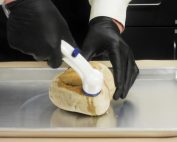Here is a Method That Is Helping: M-Vac System with Touch DNA

DNA analysis has revolutionized criminal investigations and is regarded as the gold standard in forensic science, making innovations that further DNA testing capabilities an important pursuit. Several breakthrough technologies have drawn attention over the last several years, one being the M-Vac System. The M-Vac System is an approach for collecting microscopic biological materials and retrieving pathogens from porous and rough surfaces. It can also improve the likelihood of capturing Touch DNA.
Touch DNA is a term for DNA that has been transferred from someone’s skin to items, primarily through the act of handling, holding, and in general “touching” them. Forensic techniques for collecting and testing sources of this DNA primarily target skin cells, which humans shed in the thousands daily. Although the skin’s topmost layer consists of dead cells, those cells containing small amounts of fragmented DNA are also present along the skin’s surface.
When there is no visible DNA evidence at a crime scene, such as hair, blood, or bodily fluids, Touch DNA can provide investigators with a starting point in regards to people possibly involved. The sensitivity and advancements of today’s technology also enable forensic scientists to generate DNA profiles using much smaller samples than in the past.
However, sampling methods play a key part in determining the evidentiary value of touch DNA. Forensic innovations such as the M-Vac create new ways for recovering it. Numerous variables affect the amount of biological material deposited when a surface is touched, as well as the feasibility of retrieving it.
A sterile wet-vacuum technology, the M-Vac operates similarly as a carpet cleaner. It simultaneously sprays a DNA buffer and applies suction onto the target area, which dislodges DNA materials from surfaces and substrates and suspends them in the buffer solution for capture by the vacuum. To avoid cross-contamination, the device utilizes detachable, single-use vacuum heads, tubing, and collection bottles.
The M-Vac’s system addresses some of the shortcomings of traditional DNA-sampling approaches in terms of touch DNA. For instance, porous surfaces and substrates can trap them and impact collection via techniques like swabbing, cutting, and taping. In contrast, the M-Vac is specifically designed to penetrate such compositions and recover lodged materials. It can also target a larger area than swabbing and taping when it’s not known what specific area a person of interest may have touched.
Studies on the M-Vac and its DNA-retrieval results compared to traditional sampling methods attest to the device’s efficacy in gathering touch DNA, especially from challenging surfaces. In 2020, researchers with the FBI reported findings that the M-Vac outperformed wet swabbing in DNA collection from 18 out of the 22 substrates used for testing, each of which varied in porosity.
When other traditional collection methods have been exhausted or only yielded a partial or inconclusive profile, M-Vac may be the best next step to keep the investigation moving forward.
